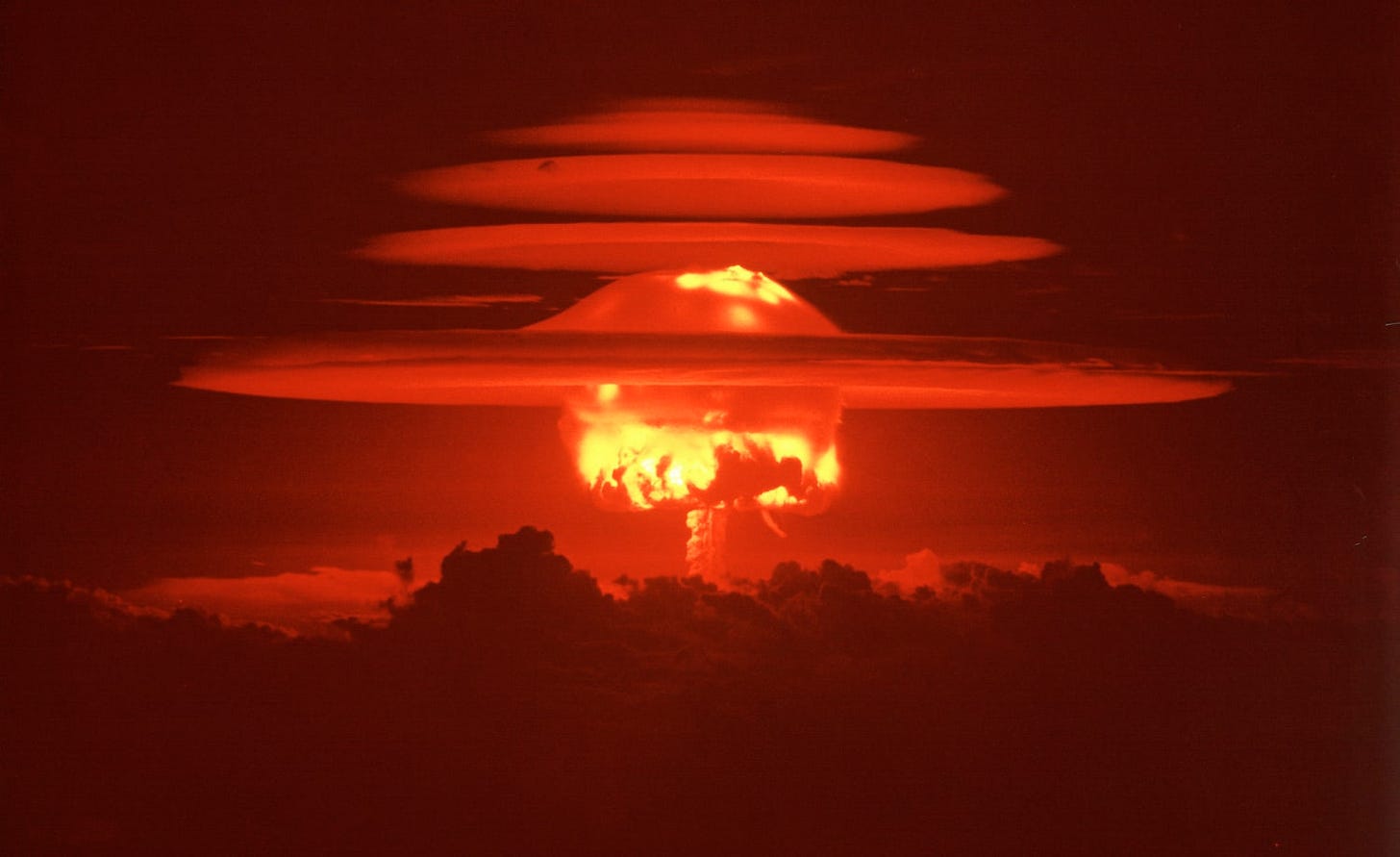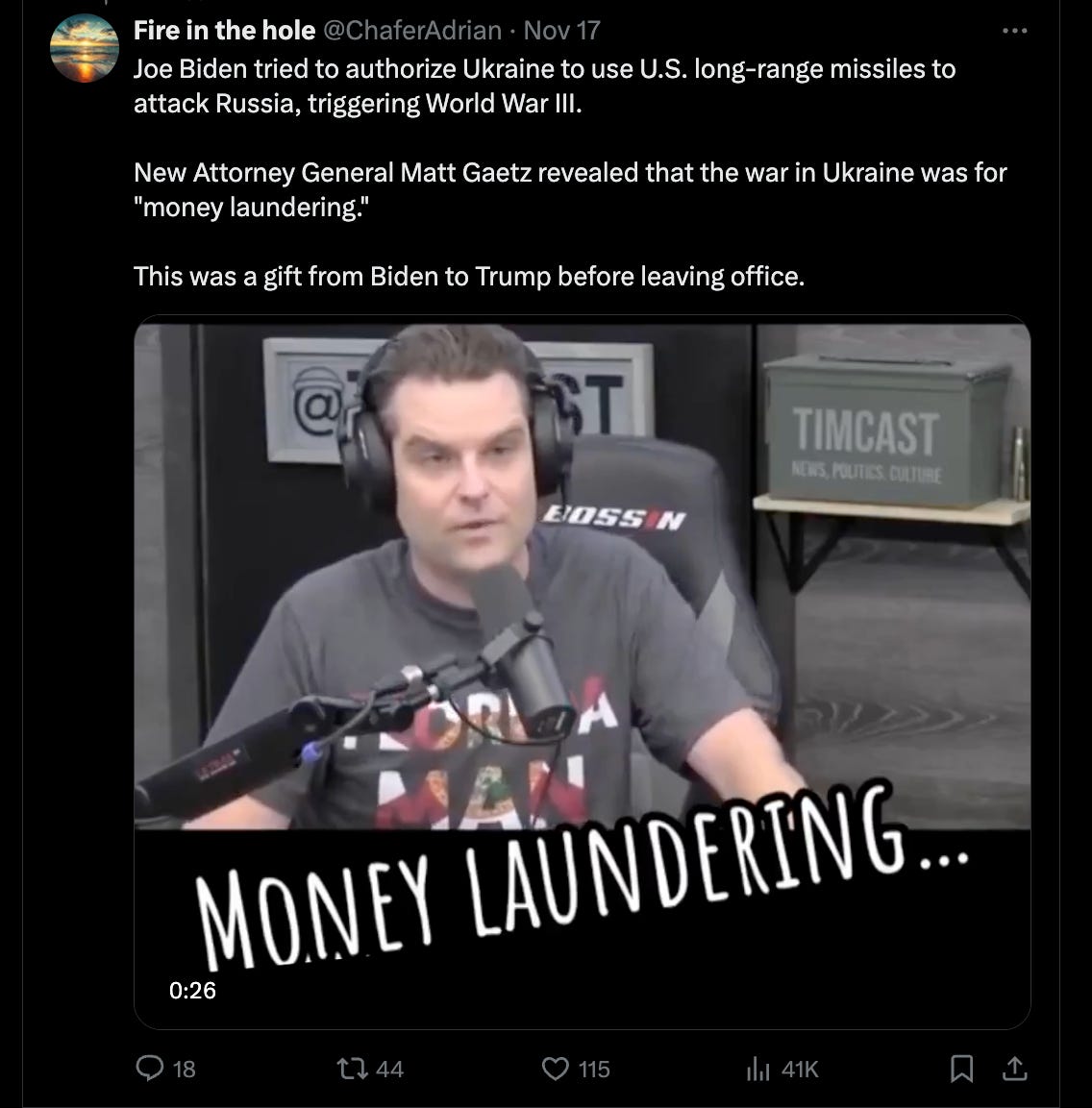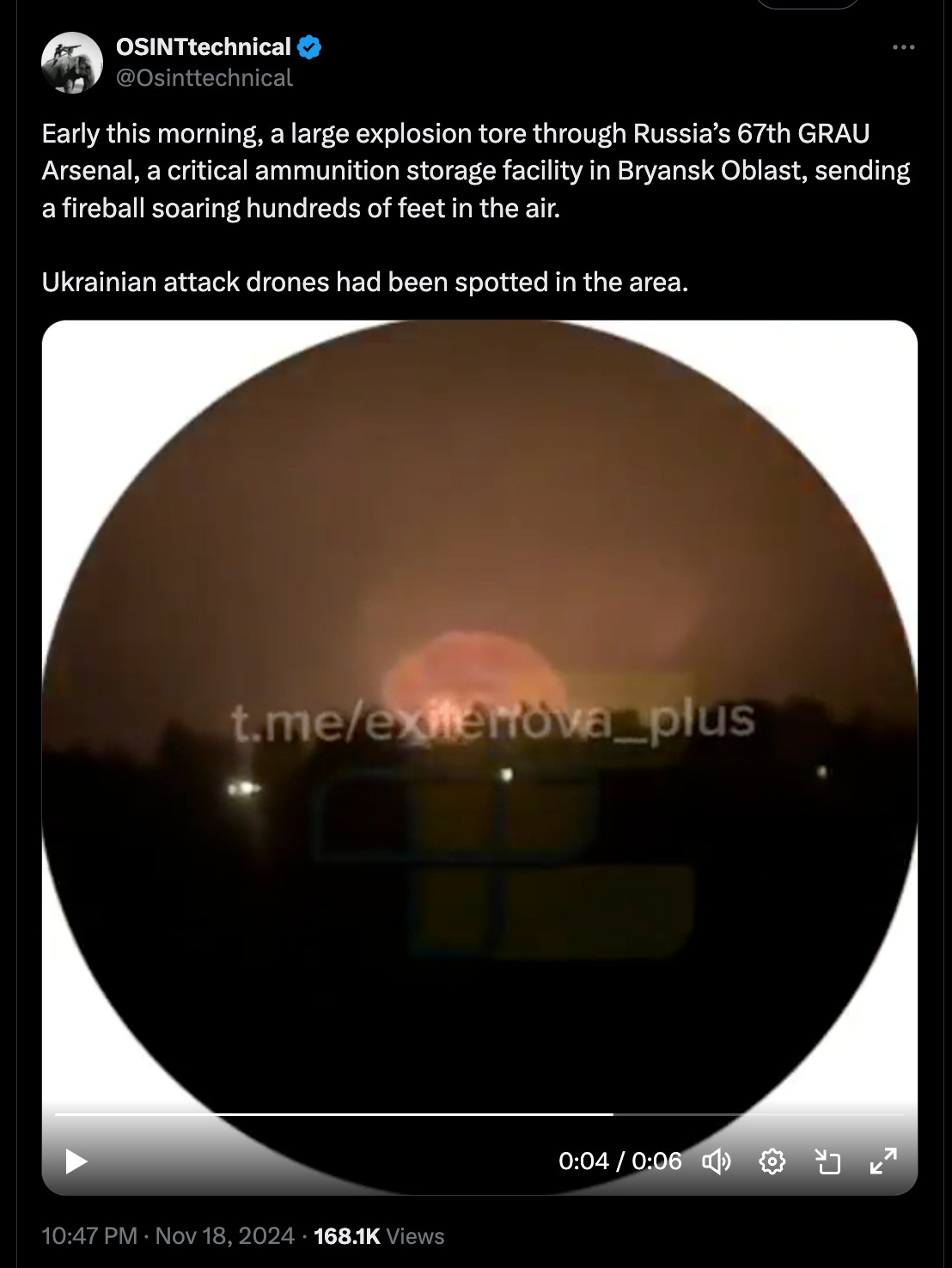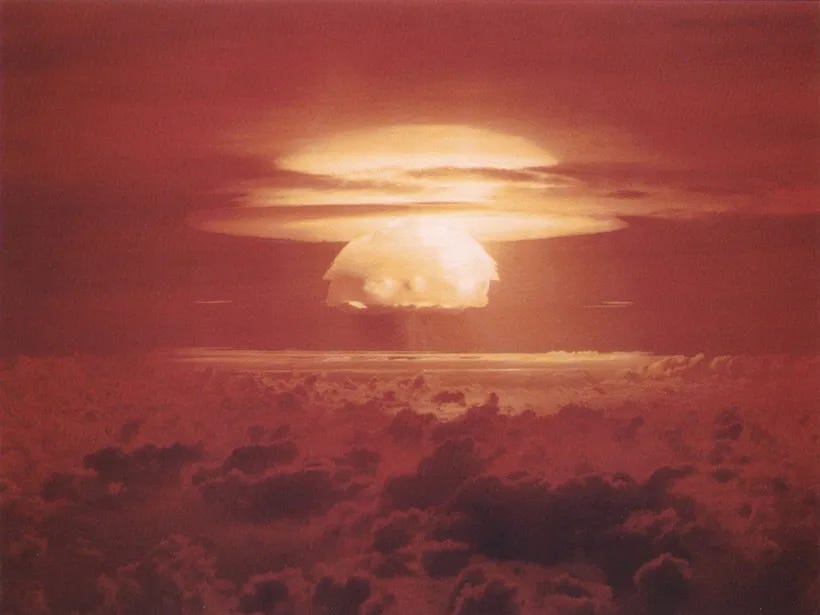Setting a Trap for Trump - Will Inauguration Day be too Late to Save the U.S. from WWIII?
Image Credit: Getty Images
After the relative calm following the 2024 U.S. presidential election, with even the warfronts in Israel and Ukraine experiencing a brief lull, a significant escalation has emerged. While minor civil disturbances occurred in Chicago, the overall atmosphere seemed to settle. Typical political squabbles over Trump’s cabinet picks were to be expected by the Democrats (& Independents hoping for less war-hawkish picks), marked the transition period. However, this past weekend, the Biden administration made a bold move that has the potential to plunge the world into a major conflict: authorizing Ukraine to employ long-range American-made, satellite-guided weapons within Russian territory. The administration justified this decision by citing the presence of North Korean troops in Russia as a critical factor.
The Biden Administration had planned to authorize Ukraine's use of long-range weapons against Russia during President Biden's meeting with UK Prime Minister Sir Keir Starmer on September 13. However, Biden ultimately hesitated and withdrew the authorization after the Pentagon cautioned about potential repercussions, as highlighted by Russian President Vladimir Putin.
President Vladimir Putin stated the following:
It is not about allowing the Ukrainian regime to strike Russia with these weapons or not. It is about making a decision about whether NATO countries are directly involved in the military conflict or not. If this decision is made [regarding the long-range missiles], it will mean nothing less than the direct participation of NATO countries, the United States and European countries in the war in Ukraine. It is their direct participation. And this, of course, significantly changes the very essence, the very nature of the conflict. This means the United States and European countries are fighting Russia.
Now that the presidential election has concluded and President Biden is seen as a 'lame duck,' would he risk the nation's future to secure his legacy? Or could it be that his administration & advisors, on their way out, aim to entangle the United States in a conflict so deeply that it creates a challenging situation for President Trump to extract the country from?
Comments by potential future Attorney General Matt Gaetz worth considering (click on picture to watch the video):
I think the reason we are as involved in Ukraine as we are, is because Afghanistan wound down. If we still had Afghanistan to launder money through, there probably wouldn’t be the need for this type of excessive involvement in Ukraine…What a lot of these defense contractors are pushing toward is how to have an extended kind of low-yield war. If there’s a way to stretch this thing out. Turn it into a 20-30 year kind of thing where there’s a whole lot of money moving around and unaccountable pots and a lot of weapons getting bought…ah man we got all these stockpiles sitting around and we’ve got to spend more money to reload those…
War is a Racket, a book by Major General Smedley D. Butler highlighted the squanders of war even back in 1935.
Dennis Kucinich stated the following on X (bracketed comments by the author):
When President Biden approved the use of supersonic Army Tactical Missile Systems (ATACMS) to strike Russia, he placed in jeopardy the national security of the United States, the safety of our troops abroad, and violated the U.S. Constitution, Article I, Section 8, which provides that only Congress can declare war.
Biden has made a decision [his handlers/military industrial complex] to insert the U.S. into an unambiguous, escalatory phase, using the territory of Ukraine to attack Russia directly with missiles which can reach 190 miles [43-186 miles per Wikipedia] deep. This is an illegal act by the President which puts our nation on a path to war with Russia.
The American people voted for Trump to end the wars. Biden apparently wants to end the world. Trump is listening to the American people. Biden is listening to NATO’s malignant agenda. Trump has put America’s interests for peace and prosperity first.
No President has the right to use unilateral executive authority to permit a U.S. missile strike against another nation. It invites a retaliatory attack. It is an impeachable offense.
Congress, as a co-equal branch of government must act now: Any member of Congress can, under privileges of the House, ask for immediate consideration of a joint resolution which invokes Article I, Section 8, and then cuts off all funding for personnel, coordination, technical advisers, material, equipment, and deployment of ATACMS and emplacement of any other missile systems in Ukraine. - Posted 11/19/24 18:03 hours
Within hours of the ‘authorization’ on the 1,000th day since the conflict between Russia & Ukraine began, a large explosion tore through Russia’s 67th GRAU arsenal, a critical ammunition storage facility in Bryansk Oblast which sent a fireball soaring hundreds of feet in the air. The facility was approximately 70 miles from the Ukrainian border.
Despite President Putin’s high level of restraint, his threats are not full of hot air. Russia’s nuclear doctrine has been revised twice since 2020. The first time in September 2024 & the second on November 19, 2024.
The Newly Revised Russian Nuclear Doctrine:
General Provisions (one very important change)
The Essence of Nuclear Deterrence (some significant changes)
Conditions for the Transition of the Russian Federation to the Use of Nuclear Weapons (very significant changes) and
Tasks and Functions of Federal State Authorities, Other State Bodies and Organizations in the Implementation of State Policy in the Field of Nuclear Deterrence (no significant changes)
Informed from 1,000 days of conflict in Ukraine and the world’s response, Russia’s new doctrine first and foremost seeks to lower the threshold for nuclear weapons use. The new doctrine accomplishes this by removing the word “exclusively” for the use of nuclear weapons (new doctrine paragraph 6: “The Russian Federation considers nuclear weapons as a means of deterrence, the use of which is an extreme and necessary measure”). It also replaces the threshold for use against actions that threaten the existence or viability of the state to include actions that pose a critical threat to Russian or Belarusian sovereignty or territorial integrity (new doctrine paragraphs 18 and 19.d, 2020 doctrine paragraph 17) including conventional attacks — a far more subjective judgement, leaving open nuclear use in far more abstract threat scenarios.
Then, in Sections 2 and 3, Russia’s new doctrine expands who it is seeking to deter with nuclear weapons, under what conditions it would use nuclear weapons, and who it is defending under its nuclear umbrella.
Section 2 expands the “who it is seeking to deter” by adding not just nuclear weapon states (e.g., the US) or states in military blocs (new paragraph 10 in the 2024 doctrine) allied with nuclear weapon states (i.e., NATO) to include states that enable attacks on Russian territory from their borders and states that have significant conventional capabilities allied with nuclear weapon states (paragraph 11) or not allied with a nuclear weapon state (paragraph 9).
In plainer terms, this now gives Russia the doctrine that any nation aligned with a nuclear state, or any state receiving assistance from any nuclear state or state aligned with a nuclear state — i.e., all of NATO — can be the target of nuclear weapons if Russia feels threatened.
Section 3 expands the part about “what conditions it would use nuclear weapons” significantly, to include not only launch on warning of ballistic missile attack (old doctrine paragraph 19 a), but a new formulation aimed towards a more comprehensive program of Launch on Warning: “receipt of reliable information on the massive launch (take-off) of aerospace attack weapons (strategic and tactical aircraft, cruise missiles, unmanned, hypersonic and other aircraft) and their crossing of the state border of the Russian Federation” (new paragraph 19 e).
Further on conditions for nuclear use, Russia’s nuclear doctrine lists dangers that might become threats that would require nuclear use. The old and the new doctrine both list the possession of WMD by adversaries, expansion of and deployment of missile defenses, buildups of conventional forces, nuclear weapons in outer space, nuclear weapons stationed on the territory of non-nuclear weapon states, and proliferation of weapons of mass destruction (the old doctrine highlighted the threat of the proliferation of nuclear weapons only, the new doctrine expands this to all WMD).
But the new doctrine adds new or expanded blocs of countries allied against Russia with military infrastructure nearby (15.f), the threat of blockades of Russia (15.g), the threat of damaging facilities that could cause widespread environmental damage (15.h) and the planning or conduct of exercises near Russia’s borders (15.i).
I guess Russia will try to deter what it does best?
Finally, Section 3 expands “who it is defending” with nuclear deterrence to include not just Russia and its allies (as in the 2020 doctrine), but specifically Belarus, and Belarus as part of the Union State (additions to paragraphs 18 and 19d), and to use nuclear deterrence Russian military forces outside its territory (new paragraph 19.b).
The remaining changes are consistent with recent developments, including central control by Russia of its nuclear forces based abroad (read: Belarus), and it eliminates any reference to compliance with arms control — a bad sign for the future of New START, scheduled to end Feb. 4, 2026.
In all, the new doctrine says that Russia will use nuclear weapons whenever the president decides to do so. It also contains a laundry list of things it doesn’t like, in an effort to try to shape Western behavior. But by expanding the role of nuclear weapons beyond “exclusively” deterrence, and by expanding the dangers that could become threats — to include military infrastructure or exercises near its borders — it risks sending ambiguous or non-credible deterrent signals that could, in turn, require Putin to act out further in order to credibly deter the West. - Breaking Defense
To put into context, Russia is 5,600 miles wide from east to west & 1,500 to 2,500 miles wide from north to south. Authorizing ATACMS to strike less than 190 miles within Russia’s borders is slightly more than 3% into the country. The shortest distance between Moscow & Ukraine is 523.07 miles via the air. Although Air Launched Ballistic Missiles may be used such as Israel Aerospace Industries LORA Tactical Ballistic Missile.
President Putin Has Been Clear on What it Takes for Peace
While Putin has repeatedly stated that Moscow was open to talks and negotiations, Peskov noted that he has also insisted that “any option of freezing this conflict will not work for us,” and said “it is important for us to achieve our goals, which are well known to everyone.”
Moscow has stated that its main goals include the demilitarization and denazification of Ukraine, as well as ensuring that Kiev legally commits to neutrality and abandons its hopes of joining NATO.
Earlier this week, the Kremlin spokesman recalled that Putin had also outlined conditions for ending the hostilities on numerous occasions, and that these steps are “what needs to be done to stop the fighting.”
In June, Putin set out a list of conditions for the immediate commencement of negotiations with Kiev, which included the complete removal of Ukrainian troops from all Russian territories, particularly the Donetsk and Lugansk People’s Republics, as well as Kherson and Zaporozhye Regions.
Last week, during his first direct phone call with German Chancellor Olaf Scholz in two years, Putin also reiterated that Moscow remained open to finding a political and diplomatic resolution to the Ukraine conflict, and said it was Kiev that was refusing to negotiate.
According to the Kremlin, the Russian president also emphasized that the crisis was the “direct result of NATO’s long-standing aggressive policy aimed at creating an anti-Russian bridgehead on Ukrainian territory, while ignoring our country’s interests in the field of security and trampling on the rights of Russian-speaking residents.”
During the call, Putin emphasized that any potential settlement between Moscow and Kiev would inevitably have to take into account Russia’s security interests, recognize the new territorial realities, and “eliminate the root cause of the conflict.” - RT
The United States Congress must decide if this madness will be allowed to continue or if Article 25 will be invoked due to an impaired president. Technically, the Vice President would step in but congress may decide to impeach the vice president.
The Constitution of the United States gives Congress the authority to remove the vice president of the United States from office in two separate proceedings. The first one takes place in the House of Representatives, which impeaches the vice president by approving articles of impeachment through a simple majority vote. The second proceeding, the impeachment trial, takes place in the Senate. There, conviction on any of the articles requires a two-thirds majority vote and would result in the removal from office (if currently sitting), and possible debarment from holding future office.[1]
Invoking Article 25 & impeaching the vice president may be a lengthy process. As of this writing, President Trump is 59 days away from his inauguration. In terms of potential nuclear war, a lot can happen in 59 days.
What is Europe’s response to all this?
Europe/NATO Countries Warn Citizens - Prepare for War
The chilling threat of a nuclear war seems closer than ever. On Tuesday, President Vladimir Putin lowered the threshold when Russia could use nuclear weapons. This came even as Ukraine fired six long-range American missiles at targets inside Russia. Nato countries, feeling the chill, issued pamphlets to their citizens, advising them on how to prepare for a war.
In the pamphlets, Sweden warned its residents to "shelter" amid fears of nuclear war breaking out, according to The Mirror of the UK. The pamphlet, issued just five times since World War II, has been sent to every Swedish household.
Norway also issued emergency pamphlets advising people to manage for a week in case of an emergency, including an all-out war, reports the BBC.
Many Nato countries are asking their citizens to be prepared for a war.
Denmark has already sent emails to its citizens to stock up on dry rations, water and medicines so that they could manage for three days of emergency, including a nuclear attack.
Finland, too, updated its online brochure on "preparing for incidents and crises" amid the escalating Russia-Ukraine war. - India Today
What About Citizens of the United States?
This is what the United States government wants you to do…
“NYC Government Posts Unnerving PSA Video For How to Respond to a Nuclear Attack” - July 11, 2022
In my previous Substack article “Civil Defense Planning-America Quit in the 90’s” , I highlighted the United States has not had a Civil Defense Plan in over 30 years whereas nations such as Switzerland, Japan, Israel, Singapore, & Germany all have well-established civil defense plans as well as invested in response training & equipment for their citizens. The bears that we’ve been poking the most as of late, Russia & China, both have extensive networks of bomb shelters & advanced warning systems. Each of the aforementioned country’s citizens actually practice where to go & what to do in an emergency.
What Can my Fellow Warriors do to Prepare?
Read my nuclear war preparedness guide:
Ignorance is not bliss. Our politicians are willing to risk our lives & civilization as we know it for ego & kickbacks. They will sit in their bunkers protected while the average citizen is left to fend for themselves. The best we can do is fight for ourselves & not get blind sided. My goal is not to fear monger but to help the strong survive.
Until next time my fellow Warriors, stay informed, stay vigilant, Ever Forward!







